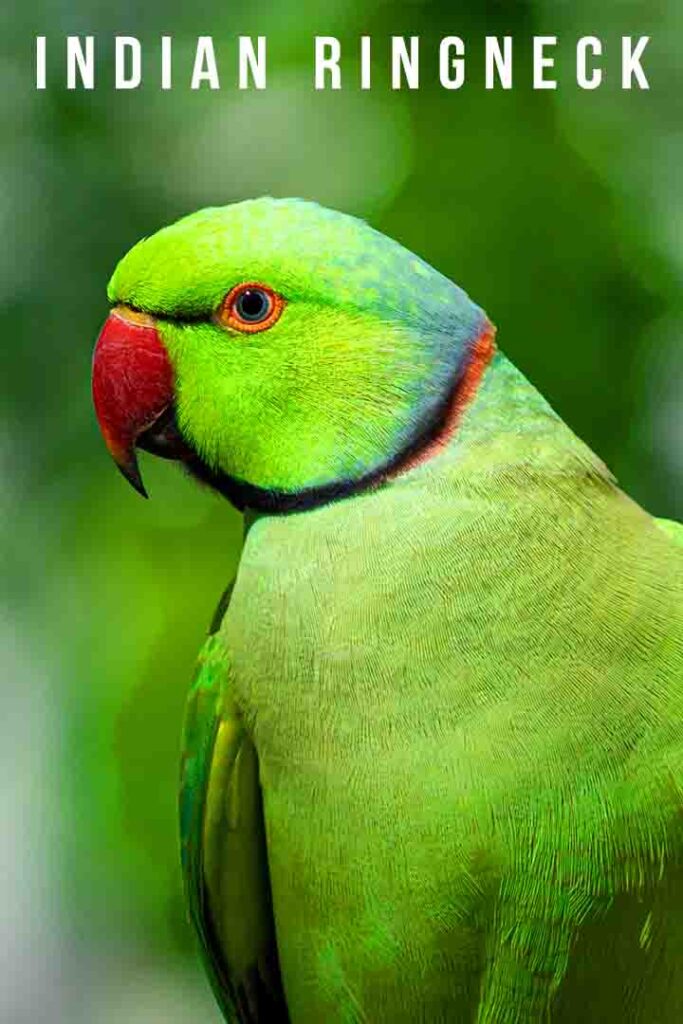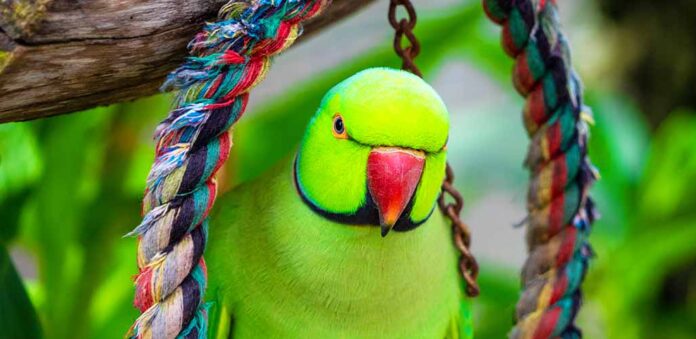This article has everything a potential Indian ringneck parrot parent needs to know. Including how to look after them, what drawbacks to consider, and the answers to questions like ‘how long do Indian ringnecks live?’ and ‘where can I find Indian ringnecks for sale?’
- Where does the Indian ringneck parrot come from?
- Indian ringneck parrot appearance
- Indian ringneck parrot temperament
- Can Indian ringneck parrots talk?
- Indian ringneck parrot health and care
- How long does an Indian ringneck parrot live?
- Where to buy Indian ringneck parrot chicks and birds
- Alternatives to the Indian ringneck parrot
- Is an Indian ringneck parrot right for me?
The Indian Ringneck parrot is a popular, medium-sized pet bird species. Indian ringnecks come in a variety of attractive colors, and grow to 16 inches long including their tail. They are extremely intelligent and sociable, and among the parrot species most likely to imitate human speech.
In this video you can see two beautiful ringnecks interacting with each other and their owner. You’ll also get a sense for how sharp and powerful their beaks are! Let’s get to know them better.
What is an Indian ringneck parrot?
Indian ringneck parrot is the better known name for the rose-ringed parakeet, or Psittacula krameri. They have been kept as pets since ancient Greek and Roman times, and they are still popular pet birds today. They are named for a collar of gray and pink plumage around the necks on male birds with wild-type plumage. But centuries of breeding in captivity has produced an array of other colors too. Amongst all the pet parrot species, ringnecks stand out for their superior speaking ability!
Where does the Indian ringneck parrot come from
Wild Indian ringnecks are native to the south Sahara in Africa, India, Pakistan, Nepal, Bhutan and Bangladesh. Since they were first captured and kept in captivity they have been exported all over the world and now they are among the most widespread non-native bird species in Europe and America.
Indian ringneck parrot appearance
Indian ringnecks measure 16 inches from beak to tail-tip, and have a wingspan of 6 to 7 inches. They have short curved beaks, which are ideal for breaking up fruits and the tough outer shell on many seeds. Like all parrots, they also have two forwards-facing and two backwards-facing toes on each foot, which helps them grip onto perches and climb.

Indian ringneck colors
Wild type coloring in sexually dimorphic. Males are green with a red beak and two rings of color around their neck: one black and one red. Females are green with a red beak, but no (or only very faint gray) rings around their neck. In captivity, a kaleidoscope of color mutations have arisen and been perpetuated by excited breeders, including
Indian ringneck parrot temperament
Like all parrot species, Indian ringnecks are extremely intelligent. They are often compared to a two year old child in terms of traits like playfulness, curiosity and problem solving ability. Since they are so clever, they benefit from plenty of toys and mental stimulation. If their environment isn’t sufficiently engaging or enriching, they are more likely to display abnormal and unpleasant behaviors. These include screaming, aggression, over grooming and self mutilation.
In a suitable environment they are notable for being exceptionally friendly with their human companions. Birds which are raised and carefully handled from chicks form close emotional bonds with ‘their’ people. This can be extremely rewarding, but also present problems if you need to leave them with someone else for any reason. These parrots are known to pine badly when separated from their favorite people.
Do Indian ringneck parrots bite?
All parrots are capable of delivering a painful bite if they feel threatened. In the wild they are prey species of larger animals, So their instinct is to bite to protect themselves if they are backed into a corner by someone they don’t know. Ringnecks raised around people and gently handled from birth are less likely to bite than ringnecks rescued from the wild, or kept in large aviaries and not handled.
Can Indian ringneck parrots talk?
Yes! Indian ringneck parrots are among the parrot species most capable of mimicking human speech. They’re more likely to be successful at it if they are raised around people and the sound of speech from a chick. Some individuals particularly enjoy learning new vocabulary, in exchange for tasty snacks! They might also learn to mimic other household sounds. Such as doorbells, ringtones, sirens, and radio or television noise.
Indian ringneck parrot health
Rose-ringed parakeets bred in captivity by responsible breeders are usually hardy and healthy pets. Some common acquired ailments of pet birds are:
- Respiratory infections. Such as aspergillosis, a fungal infection often picked up from low quality foods.
- Gastrointestinal diseases.
- Reproductive problems. Including egg binding (eggs getting stuck inside the body) due to insufficient vitamin D, vitamin E or selenium in their diet.
- Bumblefoot. Swelling and damage to the feet caused by standing or climbing in inappropriate surfaces, such as chicken wire.
Since ringneck are a prey species in the wild, they instinctively conceal when they are in pain for as long as possible, since it identifies them as an easy target for predators. Owners need to familiarize themselves with the signs to look for, so they can seek veterinary attention before it is too late. Indications a bird is in pain include:
- A hunched, head-down posture.
- Fluffed up feathers.
- Dull, half-closed eyes.
- Decreased mobility, or holding themselves in an abnormal position.
- Changes in activity or reaction to you.
- Loss of appetite.
Indian ringneck parrot lifespan
Indian Ringneck parrots typically live for 25 to 30 years in captivity. Pet birds are unlike many other domesticated species in that their lifespan in captivity is often shorter than it would normally be in the wild. This is thought to be due to widespread lack of understanding about an appropriate healthy diet for parrots and parakeets. Indian ringneck feeds sold in pet stores often contain a high proportion of small nuts and seeds. This makes their diet unbalanced – Indian ringneck birds should eat mostly vegetation and fresh fruits or vegetables. Furthermore, small seeds are so easy to consume that they can end up overeating.
So, one of the most effective ways to ensure your ringneck has the longest life possible is to feed an appropriate diet. This means including the right ratio of plants and seeds, and serving some of it as whole food or hidden food. This encourages birds to work for their meals or forage for them like they would in the wild. Which is great for their mental wellbeing too!
Indian ringneck parrot care
Caring for parrots of all types is a long term and specialist undertaking. If you’re new to owning birds, find a breeder who can mentor you in getting started. Ringnecks kept in unsuitable conditions are more likely to perform unwanted behaviors, so that you both end up miserable. The basic needs of pet parrots are:
- A cage placed at eye height in a corner. This helps them feel secure in their surroundings, because they would be able to spot predators approaching.
- 12 hours of daylight, and 12 hours of dark in every 24 hour period. If this doesn’t reflect the normal daylight period where you live, you can cover their cage with a blanket in the evening.
- A location where they get lots of human company, but not the kitchen. Fumes from Teflon pans, self cleaning ovens, baking bags and frying oils can all be fatal to birds.
- Newspaper on the floor of their cage. Not loose materials they can accidently swallow (or throw about!)
- A variety of smooth perches to use. Positioned so your bird doesn’t end up soiling their food or water bowl!
- Safe toys and environmental enrichments. Such as whole fruit and vegetables, wood with bark on it, pine cones, and hidden foods. No chains or plastic toys which are easily broken, etc.
- Opportunities to exercise and explore outside their cage every day.
Keeping Indian ringneck parrots together
As a rule, experienced ringneck owners don’t recommend novice owners getting more than one bird at a time. Female-female and male-female pairings are almost certain to fight – often with fatal consequences for the loser. Male-male pairings sometimes get along, if their enclosure is sufficiently large, and their temperaments lend them to it.
When two birds get along, this can be a great way of meeting their need for social interaction, and take the pressure off you. But, bear in mind they’re very likely to end up more bonded to each other than you. This means they may resist handling, even if one of them enjoyed it when they were a solo bird before. Finally, even for ringnecks who seem to get on, feelings can and do change. So only go down this route if you have space to move one into a separate cage if necessary.
Where to buy Indian ringneck parrot chicks and birds
It’s easy to find an Indian ringneck for sale by searching online. However, it’s worth taking your time to find an experienced bird owner and breeder. This means one who will take the time to help you get set up, and answer all your questions about getting started. This kind of investment in the future of their chicks indicates that they take the welfare of their birds very seriously.
Unfortunately, there are a lot of breeders who raise chicks poorly and sell them quickly to the first interested person. These birds are more likely to be unhealthy, and have behavioral problems. A lot of older birds are also offered for sale by people who underestimated the commitment they made when they bought them. These sellers might overstate how hand tame their bird is, to encourage you to take it away. So, take your time finding someone trustworthy.
How much are Indian ringneck parrots?
Indian ringnecks sell for between $400 and $1,500. Birds with the wild type green plumage cost the least, and birds with unusual color mutations such as a blue Indian ringneck cost the most.
Alternatives to the Indian ringneck parrot
If you’re keen on keeping a pet bird, but you’re still not sure that an Indian ringneck is the right match for you, then one of these other species might be a better fit:
- English Budgie – Is This Cute Bird Your Perfect New Pet?
- Types of Cockatiels
- Mynah Bird – A Complete Guide To The Talkative Myna Bird
- Peach Faced Lovebird – What To Expect From The Rosy-Faced Lovebird
- Fischer’s Lovebird – The Playful, Energetic Lovebird Companion
Last of all, let’s sum up the pros and cons of the rose-ringed parakeet, and how you can tell if they’re the right pet for you.
Is a Indian ringneck parrot right for me?
For experienced bird lovers, Indian ringnecks are one of the most intelligent, engaging, and beautiful species to keep. But, they are a significant undertaking. Unprepared first time owners are at risk of discovering that they’ve taken on more than they wanted, or that they can provide. Before committing to this avian friend, chat to several breeders about what to expect, and bear in mind the result of your decision could last for three decades!
Do you have a Indian ringneck parrot?
If you already have a Indian ringneck parrot then we would love to hear about them in the comments section down below. How do you keep them occupied, and what advice would you give a first time owner?
References And Resources
Baker. Parrots will be parrots – understanding parrots’ behavioural needs. Veterinary Nursing Journal. 2012.
Bottinelli et al. Herpetic Pneumonia in Indian Ringneck Parrots: First Report of Novel Psittacid Alphaherpesvirus-5 Infection in Europe. Animals. 2021.
Girling. Veterinary Nursing of Exotic Pets. John Wiley & Sons. 2008.
Malik. Pain in birds: a review for veterinary nurses. Veterinary Nursing Journal. 2018.
Parau et al. Rose-ringed Parakeet Populations and Numbers in Europe: A Complete Overview. Open Ornithology Journal. 2020.
Singh et al. Effect of bandwidth modifications on the quality of speech imitated by Alexandrine and Indian Ringneck parrots. International Journal of Speech Technology. 2017.
Uehling et al. Status of naturalized parrots in the United States. Journal of Ornithology. 2019.
Vickery & Hollwarth. Health and husbandry of companion parrots. The Veterinary Nurse. 2021.















